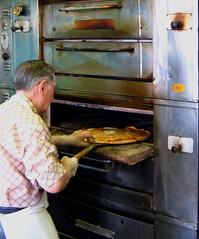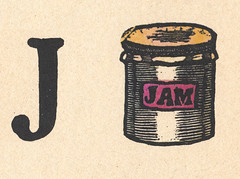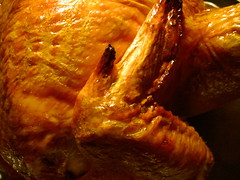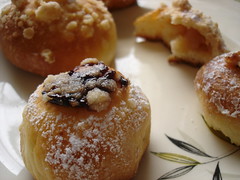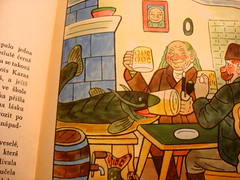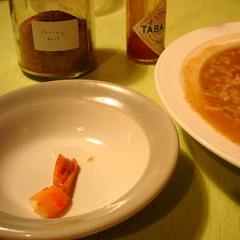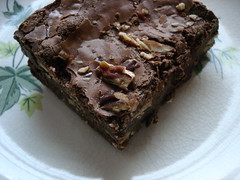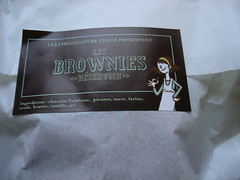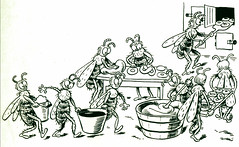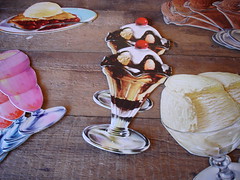Real Italian Pizza, pt. 2
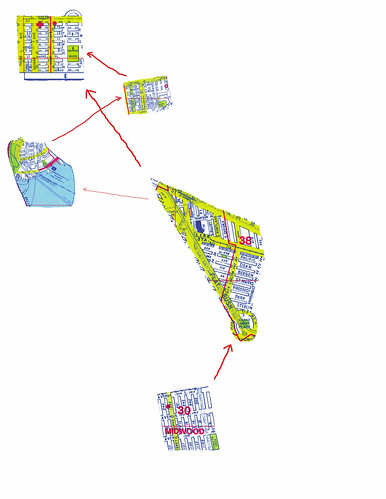 fig. a: naked city
fig. a: naked city
On the morning of New York Pizza Tour 2007, I woke up with some serious butterflies. I'd gone from being a lifelong pizza lover to being a minor-league pizza fanatic (the kind of person who might drive several hours in search of great pizza, or, apparently, the kind of person who might drive several hours to a famous pizza Mecca in order to then spend several hours wolfing down as many slices of premium pizza as he can get his hands on, as opposed to the kind of person who settles for the local delivery outfit), but in spite of my numerous visits to the Big Apple over the years, I'd yet to really face up to New York pizza. Sure, I'd had a fine coal-oven pizza from John's some 15 years ago that had been a real revelation, and in recent years I'd had a couple of other critically acclaimed New York pies and some decent slices, but I knew full well that my New York pizza education was spotty and that I'd barely scratched the surface. I limited myself to just a cup of coffee in anticipation of the pizza marathon ahead. Michelle, on the other hand, was remarkably calm and collected, and, ever the daredevil, she actually went ahead and had a few doughnuts with her coffee in spite of the awe-inspiring schedule ahead of us. By 11:00 a.m., though, we were both outside anxiously waiting for the Pizza Express to pull up and whisk us away on our adventure.
Di Fara
Adam arrived in the Pizza Express at around 11:15 and we promptly got on the Brooklyn-Queens Expressway and raced towards Midwood. Midwood is the Brooklyn neighborhood that's home to Di Fara and we had to hurry because Di Fara's renown is such that if you don't get in there nice and early you could very well end up with a 2-3 hour wait for your pizza. We had six pizza joints and seven hours of pizza eating ahead of us, so the last thing Adam wanted to do was to get caught in a snag on the first leg of the tour.
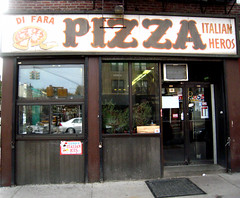 fig. b: Di Fara: Italian Heroes
fig. b: Di Fara: Italian Heroes
We got to Di Fara not long after opening time and things were still just getting underway. Domenico DeMarco, Di Fara's legendary owner/pizzaiolo, was already very much in the thick of things, but the throngs had yet to show up. About a minute or two after we arrived, Dom pulled a pan full of Sicilian "square" slices out of the oven and we got our first glimpse of that DeMarco magic: he started scissoring fresh basil leaves overtop. According to Adam, these square slices usually get snapped right up, but for some reason the punters weren't buying on this particular morning. So Adam jumped in, asked for two, and deftly managed to slip in our other pizza order too: half regular, half artichoke. It was almost too easy--within two minutes we'd had a chance to look around (it doesn't get much more old-school than this), take in the scene (eager die-hards, with just a few other first-timers), get in our order (yes!), and we were already enjoying our very first taste of a Di Fara slice.
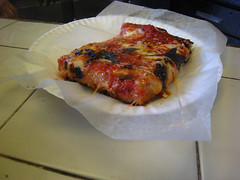 fig. c: Di Fara's Sicilian slice
fig. c: Di Fara's Sicilian slice
The Di Fara Sicilian slice is a rustic, rectangular, semi-thick-crusted number--it lacks the finesse of Di Fara's regular thin-crust pies, but it's an honest and friendly pizza slice with plenty of sauce, Di Fara's trademark trio of cheeses, and a crisp crust, and it made for a perfect hors d'oeuvre while we awaited the main event. It also got rid of any and all remaining butterflies. From that point on I was good to go.
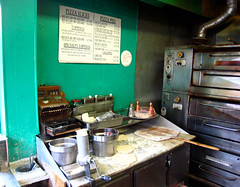 fig. d: Dom's office
fig. d: Dom's office
And wait we did. Not long, mind you, because we'd gotten our order in quickly and the crowd was still relatively small, but Di Fara is no grindhouse. Dom doesn't let anyone else touch his pizzas, and he's nothing if not attentive to every single pizza he makes, taking the utmost care with his dough, hand-grating his trademark three-cheese blend (bufala mozzarella, regular mozzarella, and Grana Padano), scissoring basil leaves over the pizza after it comes out of the oven, and giving each pizza a graceful spritz of olive oil as a parting gesture. Keep in mind: Di Fara is primarily a slice joint.
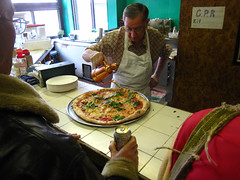 fig. e: Dom's magic
fig. e: Dom's magic
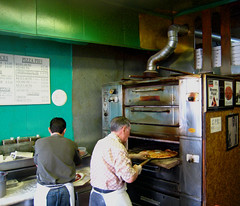 fig. f: the DeMarco boys in action
fig. f: the DeMarco boys in action
A few years ago Dom explained his unorthodox approach to pizza-making to Jeff Van Dam of the New York Times: "Pizza has become considered a fast food. This one is slow food. Anything you do, when you do it too fast it's no good. The way I make pizza takes a lot of work." Personally, we wouldn't want it any other way, because, frankly, all that work works. You can taste the care and the attention.
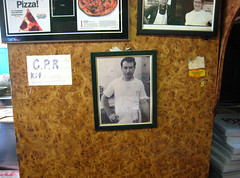 fig. g: portrait of the artist as a young man
fig. g: portrait of the artist as a young man
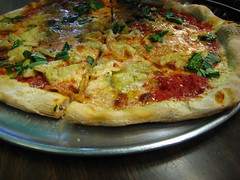 fig. h: Di Fara's regular/artichoke pie
fig. h: Di Fara's regular/artichoke pie
Both sides of our pizza lived up to our humongous expectations, but it was the artichoke half that we found particularly breathtaking. Dom being Dom, fresh artichokes--not canned--are trimmed down to their hearts and gently sauteed in olive oil before they're added to his artichoke pies. We'd heard that the artichoke hearts sometimes got a bit charred, and consequently a bit bitter, when in the oven, but our first experience of the Di Fara artichoke pie was flawless, each bite literally melting in your mouth.
This was just our first stop and already we were walking on air. We boxed up the last two remaining slices and moved on, eager for Round 2.
Verdict: home run.
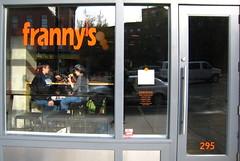 fig. i: Franny's
fig. i: Franny's
Franny's
After another short drive across Brooklyn, we arrived at Franny's to find Ed Levine waiting for us. He'd kindly given Adam, Michelle, and I a chance to get primed and up to speed, and now he was ready to take charge. You'll notice in what follows that the number of photos drops off precipitously. Part of this has to do with the fact that you'd be hard-pressed to find a restaurant of any stripe that's as photogenic as Di Fara. It's got personality to spare. Part of it has to do with Dom's particular form of perfectionism, which gave us plenty of time to snap away--though we hit some pretty serious pizza parlors after Di Fara, not one of them exercised an approach to pizza-making that was as, well, deliberate as Dom's. But a good part of this drop-off in photographic documentation had to do with Ed. Adam had alerted us to Ed's gift of the gab as we made our to Franny's, and Ed did not disappoint in the least. What ensued alongside our 8-hour pizza-eating marathon was an 8-hour food-talk marathon led by Ed, and, to be honest, we couldn't have been happier. We liked these pizza guys--they were our kind of people.
Anyway, Ed was more than ready, so he jumped right in and started ordering. Two pies, naturally, one bufala mozzarella number and one clam pie--the best one this side of New Haven, apparently. Neither of us have had the pleasure of sampling one of those legendary Pepe's clam pies, but I did have a clam pie at Mario Batali's Otto a couple of years back and it was something of a disaster. The pizza crust was good--thankfully, by that time Batali had cleared up the initial problems he'd had with his griddle pies, as documented in Bill Buford's Heat and by Batali himself in Pizza: A Slice of Heaven--and the clams themselves were delicious, but they'd been piled on top of the crust in their shells (?). Imagine what the clam shells and their cooking liquid did to the crust. Imagine trying to eat such a thing. Ed agreed that Otto's clam pie was something of a conceptual debacle, but he assured me that Franny's version had no such weaknesses.
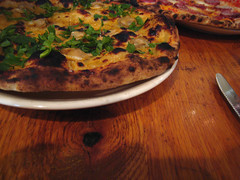 fig. j: pizza, Franny's-style
fig. j: pizza, Franny's-style
Our Franny's pizzas arrived and they looked impeccable, which is a funny thing to say about real Italian pizza or pizza with real Italian aspirations because a lot of what sets Naples-style pizzas apart are all those bits of character that novices might mistake for flaws--charring being at the top of the list. As Dom puts it, "fresh dough bubbles when you put it in the oven, and the bubbles get a little burnt. You see the pizza, and it's got a lot of black spots, it's Italian pizza. If you see pizza that's straight brown, it's not Italian pizza." A true pizzaiolo knows that charring is the price you have to pay for a pizza that's cooked properly, that's allowed its dough to reach fruition--a true pizzaiolo also knows that it's those blisters than bring out a pizza's complexities, its full potential. These were two pizzas that had definitely reached their full potential. Franny's crust was unbelievably light and wonderfully chewy, with just enough crispness, and that bufala mozzarella pie went down easy.
The real showstopper, though, was the clam pie. Dressed with Italian parsley, just a little bit spicy, rich in clam flavor, and beautifully saffron-hued, this was the clam pizza of our dreams. Turns out the pizza's alluring color comes from the fact that the clams were gently steamed in wine and then reduced, with a touch of cream added to the mix to really push them over the top. Like I said: the clam pizza of our dreams.
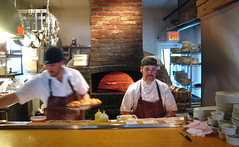 fig. k: Franny's kitchen
fig. k: Franny's kitchen
In many ways Franny's is a real anomaly. Andrew Feinberg, the head chef/co-owner, had never made pizza professionally before he opened Franny's with his wife, Francine Stephens. He was a professional chef with an impressive resumé, but he didn't have any of the usual New York pizza-making credentials (i.e. family ties to Gennaro Lombardi) and he apparently devised his pizza dough recipe very much on his own. Then he and Francine did something really orthodox: they opened Franny's as an environmentally responsible restaurant. In terms of approach to pizza-making, though, what interested me was that of the three standout pizzerias that we visited as part of our New York pizza tour, this was the only place that was also a full-service restaurant, including a bar, a large seating area, a full wait staff, a reasonably sized kitchen, and a full kitchen staff, including a team of pizza-makers. Top pizza establishments in the Neapolitan tradition live and die by the pizzaiolo. Those that have the best quality-control have as few as possible, and the best often only have one, so what we might call "the myth of the pizzaiolo" or "the pizzaiolo as hero" is crucial to your hardcore Naples-style pizzerias. I'm sure Franny's has a very select team of pizza-makers, but they're still open six days a week, including lunch and dinner on weekends, and their production volume is much higher than our other two standouts (especially during the warm-weather months, when they have a lovely patio out back). But by introducing the exacting standards of an exceedingly well-run top-notch kitchen, not only have they managed to offer an extensive menu that includes an outstanding selection of house-cured meats, they're also able to deliver on the promise of their big, beautiful brick oven.
Franny's was the one pizzeria listed on our itinerary that I'd had the pleasure of visiting previously. I'd visited one summer evening a year or so ago with a couple of hardened skeptics who were dead set on writing Franny's off. Four pizzas later, though, including an utterly daring, practically naked extra-virgin oil and sea salt pie, Franny's had left us terribly impressed (well, it left me terribly impressed and my companions quieted). This time around, I might have even left more impressed. The pizzas were extraordinary--especially that clam pie--but this time I also got a fuller sense of Franny's repertoire, including the distinct pleasure of sampling their house-cured soppressata, pancetta and bresaola plate as the warm-up act, and their phenomenal homemade fior di latte ice cream as the closer.
Verdict: home run.
Adrienne's
After two utterly transcendental pizza experiences, Adrienne's Pizzabar was considerably more down-to-earth--a little too down-to-earth. We'd gone there--to lowest Lower Manhattan, adjacent to Wall Street, of all places--in order to try a well-regarded Manhattan take on that Long Island pizza micro-genre known simply as "grandma pizza," and thereby further expand our New York pizza vocabulary. What exactly is grandma pizza, you ask? Well, it's more or less a rectangular Sicilian pie that's been made with an exceedingly thin crust, just like Nonna used to make. It's a Long Island-based phenomenon whose history as an established style dates back only about 20 years, but since then grandma pizza has popped up in all kinds of unlikely locations: Brooklyn, Pompano Beach, Las Vegas--even Lower Manhattan. Needless to say, we were very intrigued.
Our "old-fashioned" (as Adrienne's calls their grandma pies) looked pretty spectacular when it arrived at the table, but one bite and we discovered that its glorious appearance was hiding a nasty secret: it wasn't cooked through.
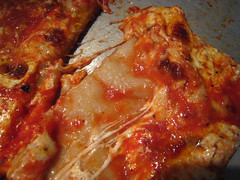 fig. l: pizza horror show
fig. l: pizza horror show
This was a major violation of one of pizza's most hallowed cardinal rules: you gotta let the pie to cook through. Ed was visibly upset. He'd already been a little taken aback by the crowd packing Adrienne's at 2:00 on a Saturday afternoon, which he took to be a sign of Lowest Manhattan's exploding population (the fastest-growing on the island of Manhattan, apparently) and not necessarily of Adrienne's astounding popularity, or the triumph of grandma pie, for that matter. But an uncooked pizza? That was too much for him. Not wanting to see a grown man cry, we quickly paid our bill and fled to the Lower East Side, hoping to get our momentum back.
Verdict: foul out.
TO BE CONTINUED...
Happened to miss Part One? Well, here it is.
aj
